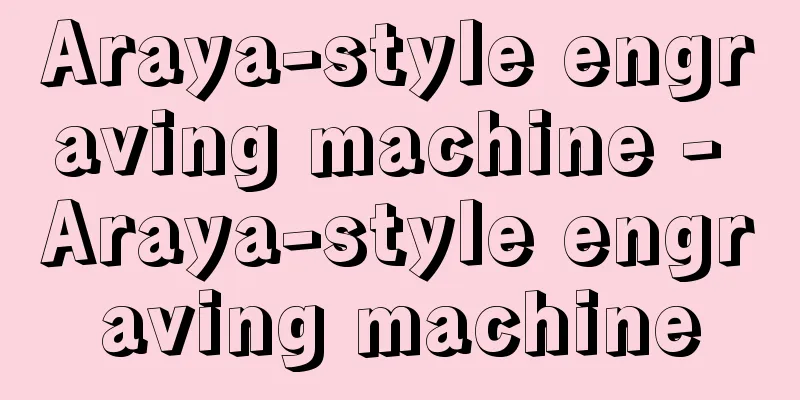Colored paper - Shikishi

|
A square thick paper on which poetry, paintings, etc. are written. There are various types of paper, such as Torinoko and Gasen paper, but there are also many other types, such as plain white paper with no decoration, dyed paper sprinkled with gold and silver leaf or sand, or paper with a sketch drawn on it. Originally, the term was used to mean dyed paper in general, as opposed to plain paper, and it already appears in Shosoin documents from the Nara period, which are still preserved in Shosoin. Also, in the Heian period "The Tale of Genji" and "The Pillow Book," there are examples of the use of "white colored paper," which also means "colored paper." The square shape of shikishi is said to have originated from shikishigata, which refers to the square frames painted in the Heian period on folding screens, shoji screens (now known as fusuma doors), or on the wall and door paintings of temples, landscape paintings, portraits, Buddhist paintings, etc., with a base coat and inscription of a hymn or poem related to the painting. Later, the paste-up style was born, and various decorations were added to dyed paper, which is thought to have been repurposed into shikishi for use as paper. The oldest example is Ogura Shikishi by Fujiwara Teika in the early Kamakura period, and ancient calligraphy such as Sunshoan Shikishi and Masu Shikishi, which were written in the Heian period, are equivalent to one page of a booklet, cut into pieces to resemble shikishigata. Eventually, during the Muromachi period, they were standardized into two formats, large and small, and their dimensions were also determined, leading to their widespread use as writing paper for poetry. While kaishi and tanzaku were used at poetry gatherings, shikishi were primarily pasted onto folding screens or albums and given as gifts. Today, they are also widely used for paintings, signs, and messages written in a book, with the currently most commonly used being 27.3 cm tall and 24.2 cm wide. There are also other types such as small shikishi and miniature shikishi. In the case of waka poetry, it is often written in four lines or scattered, and in the case of sand scattering, the side with the most white space is placed at the top. Furthermore, in the case of colored writing such as suminagashi or flying cloud patterns, it is considered unlucky to place blue or purple at the top, and so is customarily avoided. [Minoru Furuya] Source: Shogakukan Encyclopedia Nipponica About Encyclopedia Nipponica Information | Legend |
|
詩歌、絵画などを揮毫(きごう)する方形の厚紙。紙質は鳥の子、雅牋(がせん)紙などあるが、装飾のない白紙のものや、染紙(そめがみ)に金銀の切箔(きりはく)や砂子(すなご)をまいたり、下絵を描いたものなど多種を数える。もともとは白紙に対して染紙一般の意に用い、すでに奈良時代の正倉院文書(もんじょ)にもみえ、現に正倉院に伝存している。また平安時代の『源氏物語』や『枕草子(まくらのそうし)』には「白き色紙」の用例もあり、これも「色の紙」を表す。 色紙の方形の形態は色紙形(しきしがた)に由来するものとされるが、色紙形とは、平安時代、屏風(びょうぶ)や障子(いまの襖(ふすま))、あるいは寺院の壁画や扉絵に描いた山水画、肖像画、仏教絵画などの中に、方形の枠を地塗りし、そこに画面にちなむ賛語や詩歌を記したものをいう。のちに貼(は)り紙様式も生まれ、染紙に種々の装飾が加えられ、これが料紙としての色紙に転用されたものとみられる。その最古の例は鎌倉初期の藤原定家筆『小倉(おぐら)色紙』で、また平安時代書写の「寸松庵(すんしょうあん)色紙」や「升(ます)色紙」などの古筆は、冊子本の1ページ分に相当し、これを切断して色紙形に見立てたものである。やがて室町期には大小二つの形式に統一され、寸法も定められて詩歌の料紙として多用された。懐紙や短冊は詩歌会で用いられたが、色紙は主として屏風や帖(じょう)に貼り、贈答用とされた。今日では絵画やサイン、寄せ書きなどにも多用され、現在は縦27.3センチメートル、横24.2センチメートルのものが普通に用いられている。ほかに小色紙や豆色紙などもある。和歌の場合、四行、または散らし書きすることが多く、砂子散らしは余白の多いほうが上である。なお、墨流しや飛雲文様など色付きの場合、青や紫を上方に置くのは不吉とされて忌む習慣がある。 [古谷 稔] 出典 小学館 日本大百科全書(ニッポニカ)日本大百科全書(ニッポニカ)について 情報 | 凡例 |
Recommend
Teleprompter - Prompter (English spelling)
A theatrical term. A person who, out of sight of ...
Seo de Urgel
A town in the same-named county of Lleida province...
Treaty of Shimoda
A foreign treaty concluded in Shimoda, Izu during...
Phenylketonuria
[What kind of disease is it?] This disease is inhe...
Terpsiphone paradisi (English spelling)
…[Higuchi Hiroyoshi]. … *Some of the terminology ...
Long-tailed Tit
A family of birds in the order Passeriformes. Incl...
Roju Hosho - Letter of Independence
Official documents issued by the Edo Shogunate'...
English Education Council
…It is said to differ from the oral method in tha...
Cannabaceae - Asaka
Dicotyledonous, polypetalous. A climbing perennia...
British Petroleum Co., PLC (Public Limited Company)
One of the major oil companies, with the largest s...
Enclosure mountain - Kakoiyama
During the Edo period, a forest was designated as ...
Gini coefficient - Gini coefficient
A measure of inequality or disparity in income and...
Tabon Caves
A group of cave ruins located in the area of Cap...
Yasuda Yojuro - Yasuda Yojuro
Literary critic. Born April 15, 1910 in Nara Pref...
Forgetting Autumn - Akiwasure
...From the beginning, there were fixed days off ...









